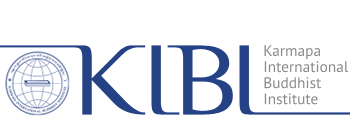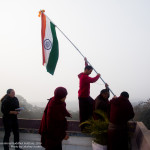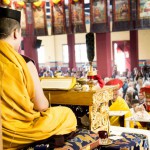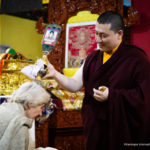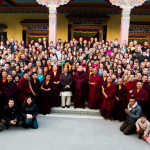Mahayana Sojong Sadhana Explanation by Khenpo Chodrag Rinpoche
December 12, 2015

(compiled by Tina Draszczyk)
Introduction
The aim of Buddhist practice is to achieve liberation from samsara. The basis of this is correct ethical behavior, rooted in what are called the vows for the individual’s liberation, i.e. the Pratimokṣa vows. In addition to including the vows for monks and nuns, these also encompass the Upāsaka- or Upāsikā vows (lay practitioners). Strictly speaking, one distinguishes between four types of Buddhist practitioners, depending on the type of vows for the individual’s liberation:
- Bhikṣu and Bhikṣuṇī, i.e. fully ordained monks and nuns,
- Śikṣamāṇa, a state in-between a female novice and a nun,
- Śrāmaṇera and Śrāmaṇerikā, i.e. male and female novices, as well as
- Upāsaka and Upāsikā. i.e. ordained lay practitioners, males as well as females (without vows of celibacy).
As it is possible to make mistakes when maintaining vows, there are various methods in Buddhism to purify oneself of these faults. One of them is the practice of Sojong. This Tibetan word, literally translated, means “purifying and restoring”.
The following instructions for the Mahāyāna Sojong are meant for Upāsikās and Upāsikās as practice on full moon and new moon. However, in the Mahāyāna it is possible to take the one-day Sojong-vows solely on the basis of the refuge, too, i.e. even without having taken the Upāsaka- or Upāsikā-vows.
In addition, practitioners with celibacy vows (i.e. Bhikṣu, Bhikṣuṇī, Śikṣamāṇa, Śrāmaṇera and Śrāmaṇerikā), who have their own form of Sojong in connection to their Pratimokṣa-vows, can practice this Mahāyāna-Sojong to purify themselves of faults which are connected to the Bodhisattva path.
In Mahāyāna Buddhism, on the basis of Bodhicitta, keeping the eight Sojong vows is often combined with the practice and recitation of certain sūtras. This is a highly effective method to purify oneself of negative karma and to reinforce and stabilize one’s orientation towards virtue.
The Sojong vows are taken with the intention to keep them the same way the Arhats kept them at the time of the Buddha. It is said that in particularly difficult times such as ours, when the teachings of the Buddha are gradually vanishing, it is especially meritorious to keep the one-day Sojong vows in an impeccable way.
The Five Upāsaka- or Upāsikā-Vows
The Vows and their benefit
By taking the Upāsaka- or Upāsikā-vows, a practitioner becomes a member of the Buddhist Sangha. In this context, two groups of Buddhist practitioners are frequently mentioned: those who live in celibacy and the Upāsaka / Upāsikā. The latter are sometimes also called the ones dressed in white.
The Upāsaka-vows entail the five śīlas, i.e. one vows not to kill, not to steal, not to lie, to refrain from sexual misconduct and not to take any intoxicating substances.
By taking refuge, a Buddhist practitioner has already consciously decided to give up negative deeds in order to avoid future suffering due to his or her own behavior. Taking the Upāsaka- or Upāsikā-vows reinforces the virtue that arises through this mindfulness in one’s conduct, and it is therefore very precious for the practitioner. The vows are also an expression of training in renouncing cyclic existence, which is the indispensable basis for a profound development towards liberation and Buddhahood, the enlightened state.
The way of life based on the Upāsaka- or Upāsikā-vow is thus the basis for the Buddhist path. This is even more true for the path of a bodhisattva — as it is only possible to help others on this basis. In addition, keeping ethical discipline is a vital condition to obtain rebirth as a human being or a god in future lifetimes, which is conductive to further spiritual development and to go on living in an ethically positive way.
The Upāsaka-vows should be taken without being influenced by kleśas, i.e. obscuring states of mind, and without the aim to obtain pleasant results or advantages for this or future lifetimes. As a Mahāyāna practitioner one should also be motivated by Bodhicitta — the wish to help all beings to achieve Buddha, the enlightened state.
The good which results from keeping the vows means that one will turn to the Dharma more and more and that one will gradually become a real Dharma practitioner; the mindfulness developed due to the vows has the effect that kleśas and deeds which cause suffering will be recognized as such. This is the basic condition to overcome negativity and is therefore invaluable for spiritual development.
As an Upāsaka or Upāsikā one either keeps one, two, three or all of the following five vows:
- not to kill: this refers to human beings;
- not to steal: this entails theft, robbery, fraud, embezzlement etc.;
- not to lie: this entails not to communicate any untruths. Within this category the pretense of spiritual experiences and realizations is particularly negative;
- no sexual misconduct: this entails, among others, unfaithfulness, types of intercourse forbidden by law (such as incest) and sexual intercourse in a temple or near a stupa;
- no intoxicating substances such as alcohol or other drugs: these cloud the mind and can therefore easily lead to deeds causing suffering. The Buddha mentioned medication dissolved in alcohol as the only exception (in case of an illness).
How to receive the Upāsaka or Upāsikā Vows and how long they last
The vows are obtained from an authentic Mahāyāna teacher, ideally a fully ordained monk or a fully ordained nun. Usually the vows are taken until one’s death, however, they can be returned following an agreement with a teacher.
How the Upāsaka or Upāsikā Vows are Broken or Damaged
The vows are broken when, in performing one particular deed, four particular factors come together. For example, the vow not to kill is broken if the following applies:
- the victim is a specific human being and it is not a case of mistaken identity;
- one has the intention to kill this particular person;
- because of this deed the person in question actually dies.
- one commits the respective deed or causes the deed to he committed, and if all four factors come together, the vow not to kill is completely broken. Otherwise it is damaged. The same principle applies to the other four vows. Damage to the Upāsaka- or Upāsikā-vows are cleared away through the eight Sojong vows, and therefore it is important to carry out this practice regularly.
The One-Day Eightfold Sojong-Practice of the Mahāyāna
As already mentioned, any practitioner who has taken refuge can use the sūtras and texts compiled here in order to practice the Mahāyāna-Sojong (Sanskrit: Poṣadha) and thus derive great benefit with relatively little effort as it is not difficult to keep the Sojong vows for the length of one day and one night.
In various Mahāyāna discourses, the Buddha advised the Upāsaka and Upāsikā to take the eight Sojong vows at full moon and new moon for a period of 24 hours. Later great Buddhist masters also repeatedly recommended the practice of the Mahāyāna Sojong to their disciples.
The reason for the strong emphasis on this practice rests in its great benefits. It is not only a very effective method to purify oneself of damage in relation to the Upāsaka-vows, but in addition it is of great benefit for the practice of the Bodhisattva- and the Vajrayāna. If the Sojong vows are taken and maintained with the motivation of Bodhicitta, they can also clear away minor damage in relation to the Bodhisattva-and the Vajrayāna vows.
The Sojong practice for Upāsaka or Upāsikā in the Mahāyāna derives from the type of Sojong practice given by the Buddha in the Vinaya discourses for monks and nuns, who were encouraged to practice Sojong at full moon and new moon in order to purify damage to their vows. The Sojong practice for monks and nuns, as well as the one for the Upāsaka and Upāsikā, results in the strengthening and stabilizing of virtue in the mind stream of the practitioner. By taking the Pratimokṣa-vows, virtue arises in the mind which remains by keeping the vows, as long as the vows are not broken. Damage which does not break the continuity of the vow completely, but merely impairs it, weakens this virtue thereby diminishing the positive effect of the vows. This damage is purified by the practice of Sojong thereby enabling the unhindered continuity of virtue.
The Eight Sojong Vows
- Not to kill: this means not killing any sentient being. Therefore one also refrains from eating any meat or fish on this day.
- Not to steal: not to take what one has not been given; this entails theft, robbery, embezzlement etc.
- Not to lie: not to communicate any untruths, particularly not in relation to one’s spiritual development.
- To refrain completely from engaging in any sexual conduct.
- Not to take any intoxicating substances: this includes liquor and any other drugs.
- Not to eat food at the wrong time: only breakfast and lunch should be eaten. The latter around midday, i.e. to begin it at around 12.00 and to finish it at approximately 12.30 p.m. No further food should be eaten until the next morning. However, one may drink water and tea.
- Not to sit on high or precious seats: one should refrain from sitting or lying on seats or beds which are higher than approximately 35 cm.
- Not to adorn oneself: one should not wear any jewelry, use perfume, dance or sing.
How to take the eight Mahāyāna Sojong Vows
The vows are taken at dawn when there is enough light to see the lines on the palm of one’s hand. They should be taken either in the presence of a spiritual teacher or in front of a symbol of the Buddha, i.e. a statue or a picture. It is best to take the vows as a group because this enhances the harmony of the particular sangha. It is, however, also possible to take the vows alone.
The Sojong vows are taken as follows:
- First of all you make offerings at the shrine and prostrate three times.
- Then the Three Jewels – Buddha, Dharma and Bodhisattva-Sangha – should be visualized in the sky in front of you. You take refuge at the Mahāyāna level in their presence and develop the Four Immeasurables, i.e. you develop infinite love, compassion, joy and equanimity.
- Bless the place in which you practice, i.e. you visualize it as perfect in every respect.
- Then you invite the Buddhas and Bodhisattvas in order to take the eightfold Sojong vows in their presence and to make them witness your confession of all negative deeds.
- In order to accumulate merit, you now go through various recitations in the presence of all Buddhas and Bodhisattvas: the offering of ablutions and of clothes, the prayer of praising the Buddha and his twelve deeds, as well as the prayer in seven parts.
- This is followed by three further prostrations. After the prostrations, you sit with your right knee down and left knee up, fold your hands and take the eight Sojong vows until the next morning.
- The next step is to sit down in the usual meditation posture and recite the Sūtra of the Recollection of the Noble Three Jewels.
- Then you recite the Triskandha Sūtra (the Sūtra of the three Skandhas) which is also known as the Sūtra Purifying Downfalls on the Bodhisattva Path.
- Finally you dedicate the merit to the welfare of all beings and you make aspiration prayers.
Just before lunch you should recite the Sūtra of the Recollection of the Noble Three Jewels again and make offerings. Right after lunch you can recite the Heart Sūtra and possibly the Warding-off of Obstacles which is connected to it. During the afternoon or evening you should again recite various sūtras, such as the Sūtra of the Recollection of the Noble Three Jewels and the Heart Sūtra together with the Warding-off of Obstacles. The vows are to be maintained until the following morning. No special practice is required to conclude them. However, it is recommended that you recite the King of Aspiration Prayers of Noble, Excellent Activity or an equivalent aspiration prayer right after getting up in the morning.

